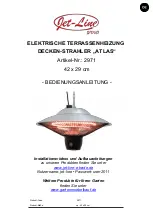
7
the eliminator (self-cleaning system)
These units include The Eliminator (Self-Cleaning System)
installed in the front water inlet, See Figure 1. The Eliminator inlet
tube can only be used in the front water inlet connection. Do not
install the Eliminator inlet tube in either the top or back inlet water
connection. The Eliminator must be oriented correctly for proper
function. There is a marked range on the pipe nipple portion of
the Eliminator, that must be aligned with the top of the inlet spud.
A label above the jacket hole has an arrow that will point to the
marked portion of the pipe nipple if the orientation is correct. If
the arrow does not point within the marked range on the pipe
nipple, adjust the pipe nipple to correct. A pipe union is supplied
with the Eliminator to reduce the probability of misaligning the
Eliminator accidentally while tightening the connection to the
inlet water supply line. Improper orientation of the Eliminator
can cause poor performance of the heater and can significantly
reduce outlet water temperatures during heavy draws.
note: the eliminator may have 1, 3 or 7 cross tubes.
figure 1.
high limit switch
The digital thermostat (Figure 2) contains the high limit (energy
cutout) switch. The high limit switch interrupts main burner gas
flow should the water temperature reach 203°F (95°C).
In the event of high limit switch operation, the water heater
cannot be restarted unless the water temperature is reduced to
approximately 120°F (49°C). The high limit reset button on the
front of the control then needs to be depressed.
Continued manual resetting of high limit control, preceded by
higher than usual water temperature is evidence of high limit
switch operation. The following is a possible reason for high limit
switch operation:
• A malfunction in the thermostatic controls would allow the gas
valve to remain open causing water temperature to exceed the
thermostat setting. The water temperature would continue to
rise until high limit switch operation.
Contact your dealer or qualified service agency if continued high
limit switch operation occurs.
digital thermostat
figure 2.
electronic ignition control
Each heater is equipped with an ignition control. The solid state
ignition control (Figure 3), ignites the main burner by utilizing a
silicon nitride igniter. The silicon nitride igniter shuts off during
the heating cycle and the main burner flame is sensed through
a remote flame sensor integral to the silicon nitride igniter
assembly.
The ignition control will try to ignite the main burner three times
before lockout. Then it waits one hour before trying again to ignite
the main burners. This is a continuous cycle.
ignition control
figure 3.
exhaust inducer (Blower assy.)
All models are equipped with an exhaust inducer. The inducer
assists in drawing in fresh air to the unit for combustion and then
assists in dispensing the combustion by-products into the venting
leading outside.
The exhaust inducer is equipped with a gravity controlled damper
to reduce the amount of heat loss through the flue, improving
efficiency.
exhaust inducer
figure 4.
uncrating
The heater is shipped with the inducer already installed. The
wiring conduit runs from the thermostat to the inducer. Before
turning unit on, check to make sure the wiring conduit is securely
plugged into the inducer.
features and components
Summary of Contents for BTC 151
Page 51: ...51 Notes...








































